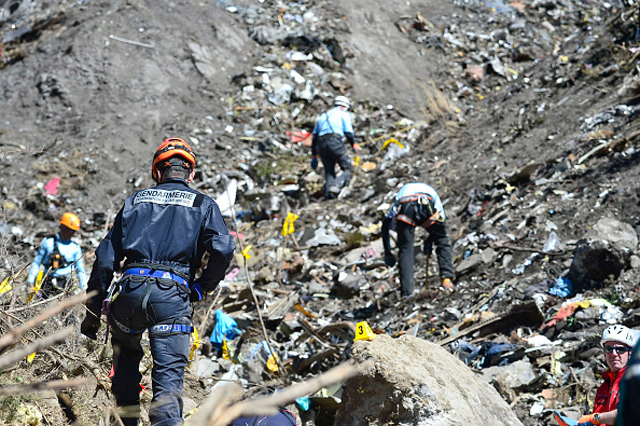Airline pilot organisations have expressed their shock at the Germanwings Airbus A320 crash on 24 March – but also their distress that international standards for investigation and the release of information are not being followed.
The European Cockpit Association (ECA) says it accepts that the information released suggests the co-pilot probably acted deliberately to destroy the aircraft, but maintains that the failure to respect agreed accident investigation protocols is damaging the process of investigation itself and endangering aviation safety.
In France, a judicial prosecutor always works in parallel with air accident investigators to assess evidence at a crash site. The expert accident investigator – in this case the French BEA – is the junior partner in the early stages of the task, and must await the judiciary’s assessment and securing of the evidence. Lacking aviation expertise, the prosecutor’s sole task is to determine who is to blame and whether criminal prosecution is appropriate, while the BEA’s sole task is to determine the cause of the crash so as to prevent a recurrence.
However, this mixing of roles is contrary to the International Civil Aviation Organisation’s standards and recommended practices for accident investigation set down in Annex 13 to the Chicago Convention.

Getty Images
In the Germanwings case, as soon as the A320’s cockpit voice recorder had been found and successfully downloaded, the prosecutor announced to the world’s media – on camera, and in the presence of the BEA team – that the co-pilot appeared to have deliberately flown the aircraft into the ground. In effect prosecutor was saying that he was satisfied there was sufficient evidence to bring a prosecution against the aircraft’s co-pilot.
But following the prosecutor's announcement, the ECA had this to say two days after the accident: “European pilots are deeply disturbed by the latest turn in the investigation of the tragic Germanwings flight 4U 9525 crash. The reports of investigators and French prosecutors that this could be a result of a deliberate attempt to destroy the aircraft are shocking and our thoughts are with the victims and their relatives.”
The Association then voiced its concerns about the investigative process: “We stress the need for unbiased, independent investigation into the factors leading to this accident. The leaking of the CVR data is a serious breach of fundamental and globally-accepted international accident investigation rules… Given the level of pressure this leak has undoubtedly created, the investigation team faces a serious distraction. The required lead of safety investigators appears to have been displaced by prosecutorial considerations. This is highly prejudicial, and an impediment to making aviation safer with lessons from the tragedy.”
If the BEA alone had been left to release the information, it would have provided established facts only – and not made any conclusions public at this early stage, however obvious they might appear to be.
The A320 took off from Barcelona, Spain on 24 March at 10:00 local time for flight 4U9525 to Düsseldorf, Germany, carrying 144 passengers and six crew. At about the time the aircraft reached its 38,000ft cruise level the captain left the flight deck, and very soon after that the aircraft began a continuous but controlled descent to impact. On his return to the flight deck the captain was unable to regain access to the cockpit.
Marseille air traffic control called the Germanwings flight several times, but the co-pilot did not reply to any of the calls. The chief investigator says the co-pilot manually initiated an autopilot-controlled descent, and his breathing could be heard throughout. The rate of descent – about 4,000ft/min – would not be unusual for an expedited descent on a normal flight.
The ECA states: “We understand that many facts point to one particular theory for the cause of this event. Yet, many questions still remain unanswered at this stage. A key priority for accident investigators – and prosecutors – must be to gather and analyse thoroughly all data, including the technical information about the flight.”
An example of the ECA’s concerns would be fact of the co-pilot’s breathing. While the prosecutor implied that the breathing indicated the co-pilot was alive during the descent, pilots have commented that some form of incapacitation cannot be ruled out on that information alone.
As a result of the official prosecutorial assumption of the co-pilot’s deliberate destructive action, the ECA argues that the understandable worldwide media reaction has placed pressure on the BEA – and this has the potential to influence the investigation.
Source: FlightGlobal.com
















